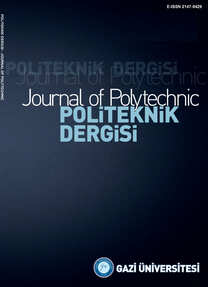Düşen Ağırlıklı Düşük Hız Balistik Testi ve Farklı Metal Türlerindeki Hasarı
Darbe hasarı, düşük hız balistiği, balistik test, dayanım katsayısı, balistik dayanım
Falling Weight Low Velocity Ballistic Testing and Its Damage on Different Type of Metals
Impact damage, low velocity ballistic, ballistic testing, strength coefficient, ballistic resistance,
___
- [1] Evci C. “Analysis of the effect of propellant temperature on interıor ballistics problem”. Journal of Thermal Engineering, 4(4): 2127-2136, (2018).
- [2] Interior Ballistics of Guns, Ballistic Series, Engineering Design Handbook, US Army, (1965).
- [3] Research and development of Materiel, Elements of Armament Engineering, Part 2: Ballistics, Engineering Design Handbook, US Army, (1963).
- [4] Kiliç N. and Ekici B., “Ballistic resistance of high hardness armor steels against 7.62 mm armor piercing ammunition”, Materials and Design, 44:35-48, (2013).
- [5] Übeyli M., Yildirim RO. and Ögel B., “On the comparison of the ballistic performance of steel and laminated composite armors”, Materials and Design, 28(4):1257-1262, (2007).
- [6] Rahman NA., Abdullah S., Zamri WFH., Abdullah MF., Omar MZ. and Sajuri Z., “Ballistic limit of high-strength steel and Al 7075-T6 multi-layered plates under 7.62-mm armour piercing projectile impact”, Latin American Journal of Solids and Structures, 13: 1658-1676, (2016).
- [7] Gupta K. and Madhu V., “An experimental study of normal and oblique impact of hard core projectile on single and layered plates”, International Journal of Impact Engineering, 18: 395-414, (1997).
- [8] Resnyansky AD., “The impact response of composite materials involved in helicopter vulnerability assessment: Literature Review - Part 2”, Weapons Systems Division, Defence Science and Technology Organisation, Department of Defence, DSTO-TR-1842 Part 2, Australia.
- [9] Johnson GR. and Cook WH., “A constitutive model and data for metals Subjected to large strains, high strain rates and high temperatures”, Proceedings of the Seventh International Symposium on Ballistics, 19-21 April, The Hague, 541-547, (1983).
- [10] Bowen AW. and Partridge PG., “Limitations of the Hollomon strain-hardening equation”, Journal of Physics D: Applied Physics, 7: 969-978, (1974).
- [11] Warnet L. and Reed PE., “Falling weight impact testing principles”, Ed. By G. W. Swallowe in “Mechanical Properties and Testing of Polymers”, Springer Science, Dordrecht, (1999).
- [12] Zhongping Z., Weihua W., Donglin C., Qiang S. and Wenzhen Z., “New formula relating the yield stress-strain with the strength coefficient and the strain-hardening exponent”, Journal of Materials Engineering and Performance, 13(4): 509-512, (2004).
- [13] Rajput A. and Paul SK., “Effect of different tensile loading modes on deformation behavior of nanocrystalline copper: Atomistic simulations”, Results in Materials, 4:100042, (2019).
- [14] Zhao JZ., De AK. and De Cooman BC., “Kinetics of Cottrell atmosphere formation during strain aging of ultra-low carbon steels”, Materials Letters, 44: 374-378, (2000).
- [15] Ishii H. and Yukawa K., “The role of dislocation substructures in fatigue crack propagation in copper and alpha brass”, Metallurgical Transactions A, 10A: 1881-1887, (1979).
- [16] Shintani T. and Murata Y., “Evaluation of the dislocation density and dislocation character in cold rolled Type 304 steel determined by profile analysis of X-ray diffraction”, Acta Materialia, 59: 11, 4314-4322, (2011).
- [17] Müller S. and Zunger A., “Structure of ordered and disordered α-brass”, Physical Review B, 63: 09420, (2001).
- [18] Hirth JP. and Lothe J., Theory of Dislocations, McGraw-Hill, New York, (1982).
- [19] Wang H., Jing H., Zhao H., Han Y., Lv X. and Xu L., “Dislocation structure evolution in 304L stainless steel and weld joint during cyclic plastic deformation”, Materials Science and Engineering: A, 690: 16-31, (2017).
- [20] Pereira JCC., Rodrigues PCM. and Abrão AM., “The surface integrity of AISI 1010 and AISI 4340 steels subjected to face milling”, J Braz. Soc. Mech. Sci. Eng., 39: 4069–4080, (2017).
- [21] Kim G., Rempe JL., Knudson DL., Condie KG. and Sencer BH., “In-situ creep testing capability for the advanced test reactor”, Nuclear Technology 179(3):413-428, (2012).
- [22] Kalpakjian S and SR. Schmid, “Manufacturing Engineering and Technology”, 7th Edition, Pearson, NY, (2013).
- [23] Callister, DW., Materials Science and Engineering, 6th Edition, Wiley, (2005).
- [24] He G., Dou Y., Guo X. and Liu Y., “Effects of grain size on ballistic response of copper materials”, Proceedings of the ASME 2017 International Mechanical Engineering Congress and Exposition in IMECE2017, November 3-9, 2017, Tampa, Florida, USA.
- [25] Chung DDL., “Review materials for vibration damping”, Kluwer Academic Publishers, N.York, (2001).
- [26] Uslu E. and Tosun N., “Experimental investigation of springback of DC series steel sheet in V-bending process”, Bayburt Üniversitesi Fen Bilimleri Dergisi, 2(2): 300-306, 82019).
- ISSN: 1302-0900
- Yayın Aralığı: 6
- Başlangıç: 1998
- Yayıncı: GAZİ ÜNİVERSİTESİ
Hamid ASADİ DERESHGİ, Kasım SERBEST, Büşra BALIK, Sema Nur SAHIN
Aslıhan KURNUÇ SEYHAN, Sinem UZUN, Salih COŞKUN
Dijital Pazarlama Strateji Seçimi: SWOT Analizi Ve Çok Ölçütlü Karar Verme Yöntemleri
Elektrikli Araç Batarya Aktif Dengeleme Sistemleri için Çift Yönlü Flyback Dönüştürücü Tasarımı
Tuncay KARAÇAM, Halil VARİYENLİ, Kerim MARTİN, Ataollah KHANLARI, İpek AYTAÇ
GaN/AlInN/AlN/Safir HEMT Yapılar için Mozaik Kusur ve AFM Çalışması
Ahmet Kursat BILGILI, Erkan HEKİN, Mustafa OZTURK, Süleyman ÖZÇELİK, Ekmel ÖZBAY
Manyetik Anomali Yöntemi Kullanılarak Düşük Maliyetli Mayın Dedektörü Tasarımı
Mehmet Fatih IŞIK, Çağrı SUİÇMEZ, Cemal YILMAZ
Orhan DOGAN, Yunus GENÇ, Orhan Gazi ODACIOĞLU
Tarama Modeli Kullanan Karma Bir Görüntü Şifreleme Yöntemi
Kimyasal Silahların Bertarafında Termal Yöntemler ve Plazma Teknolojisinin Bilgisayar Modellemesi
